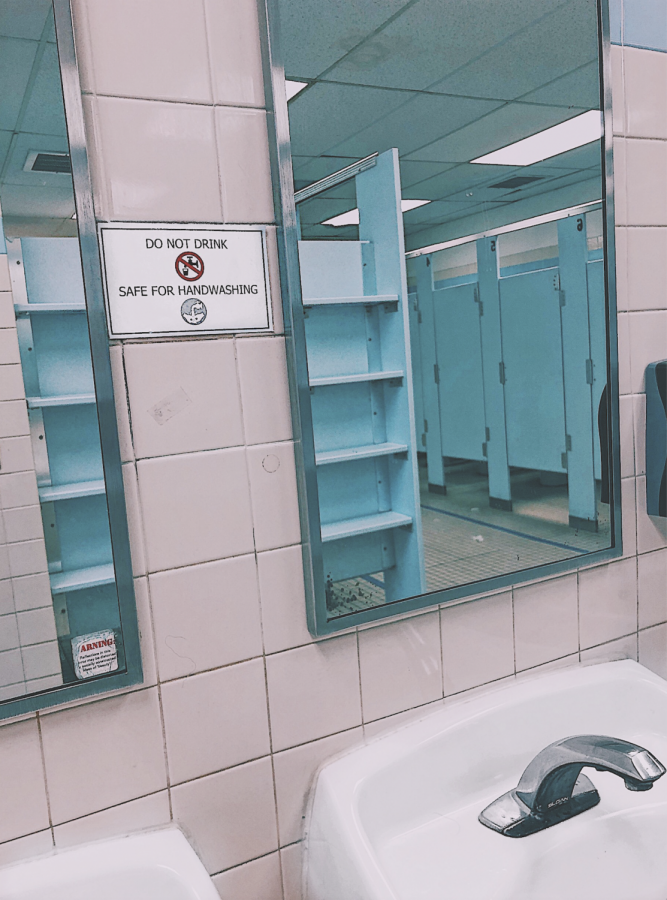Water quality at WHS: Thirsty for answers
Photo photo by Audrey Pucciarelli
“Do Not Drink Sign” from the girls bathroom in the main hallway
“Do not drink. Safe for handwashing.” We have all seen this warning posted in the WHS bathrooms, and it raises some questions: Why is the sink water unsuitable for consumption? If the water in the sinks is unsafe, what makes water from the fountains any better?
These signs trouble members of the WHS community. Drama Teacher Daniel Devlin said: “I am sure that the water in this community is perfectly safe, but it’s weird to see a sign that tells you not to drink the water. Those signs do make you stop and think about what you’re drinking.”
Jerry Leatherman, a member of the district maintenance team, provided an explanation for the warnings. Unlike the water fountains, the bathroom sinks are not filtered or included in district water tests, so the quality and safety of the water has not been confirmed. The signs are there as a precaution to discourage people from drinking the sink water.
According to Leatherman, there is, in fact, much thought put into ensuring the safety of the water in the drinking fountains. The district put extensive research into choosing the highest-quality filters, which are replaced semiannually. Despite popular belief, the appearance of a red light on the filters does not mean the water is unsafe; it simply measures how much time has passed since the last filter replacement and serves as a reminder to the custodians to replace them. Leatherman emphasized that students can drink the water without fear because the fountain water passed all requirements in the last district-wide test in August 2017.
But, what about the untested sink water? Hi’s Eye staff decided to investigate potential dangers in the water, purchasing the H2O OK drinking water test kit from Home Depot, which promised to “provide immediate results on 23 dangerous water contaminants and unwanted conditions.”
Test results from the girls bathrooms in the main hallway and language hallway showed that WHS sink water has acceptable levels, or is entirely free of, most concerning substances including lead, chlorine, and bacteria.
However, the test did reveal one troubling result: The sink water tested positive for pesticides. The Safe Drinking Water Foundation states that “pesticides are potentially toxic to humans and can have both acute and chronic health effects including irritation of the skin, cancer and hormone defects.” Hi’s Eye staff tested two water fountains; both tested negative for pesticides.
In spite of the fact that most people do not drink the sink water, news of the pesticides still worries members of the WHS community. “It might not be the end of the world since it’s just your hands,” said junior Caroline Gallagher. “But you wash them and then go and eat, drink or touch your face.”
While pesticides in the sink water may be distressing, WHS is lucky to have clean, filtered drinking water because it is not available nationwide. According to a 2019 report from the Environment America Research and Policy Center, there is “a pattern of widespread contamination of drinking water across America.” According to the study, only 43 percent of U.S. school districts test the water, and one third of those districts had water that was deemed unsafe.
“Water contamination is a very common and pervasive issue, especially in parts of the country that are or were historically very industrial,” said Environmental Science Teacher Kathleen Bigelow. “We need to address pollution that we know is present and clean it up.”
The Trump Administration, however, does not appear to be prioritizing the issue of drinking water safety. In late April of 2019, the Environmental Protection Agency cut down on regulations for chemicals in drinking water.
According to The New York Times, “the EPA has weakened a proposed standard for cleaning up pollution that contaminates drinking water consumed by millions of Americans.” Exposure to the toxic chemicals found present in the polluted drinking water has been linked to a number of harmful conditions and diseases, including high cholesterol, kidney cancer and developmental delays.
One incident at Washington Elementary School showed the importance of strict laws regarding drinking water. In 2014, after a law was passed stating that all water fountain parts are required to be lead-free, a test revealed that the heads of the school’s fountains contained lead. According to the World Health Organization, lead is a cumulative toxicant that affects multiple body systems and is particularly harmful to young children. There is no known level of lead that is considered to be safe; any exposure is dangerous. The water at Washington was shown to be safe, but the fountain heads posed a risk and had to be replaced in order to adhere to the new regulations.
This particular incident caused concern within the community. “It was a very upsetting situation,” said Washington parent Teresa Culkin. “Lead-contaminated water is a very serious issue that shouldn’t be affecting our town.”
Despite the initial shock, the incident at Washington resulted in beneficial long-term changes to the school district’s policy on drinking water. All water fountains within the district were replaced with advanced equivalents.
These new fountains satisfied parents. “I’m glad that they found the issue and addressed it,” said Culkin. “I am very happy with the new fountains and I think they’re getting a lot of use at Washington. They’re a great addition because even without the lead, those were incredibly old fountains.”
As for WHS, there is no apparent reason to fear a similar situation. There is a filtered, free source of water from lead-free fountains available in every hallway.

